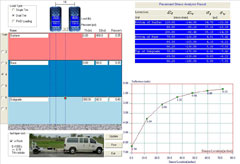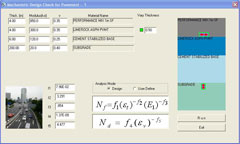TTI Updates Pavement Design Software


One of the best parts of a software upgrade is seeing the new features. Releasing next-generation software often requires a much-needed modernization of the hardware. Sometimes, though, it’s the other way around. Texas’ roadways — the state’s biggest collection of hardware —are being modernized, and that’s required the updating of the software used to design them.
FPS19, the current version of the pavement design software used by the Texas Department of Transportation (TxDOT), computes the required thickness of pavement layers to withstand the damaging effects of both traffic and the environment. It also calculates the required overlay thickness for existing highways and lets the designer estimate stress and strain within the pavement layers, as well as make predictions of pavement life.
Recently, a new generation of perpetual pavement (PP) structures has evolved to meet ever-increasing traffic loads. A PP structure is a long-lasting, thick, hot-mix asphalt (HMA) pavement structure with a design service life of up to 50 years. A typical Texas PP structure consists of several layers of HMA, a high-quality base layer over a treated subgrade material.
“You build a thick asphalt pavement, and you never have to repair anything except the surface. The largest trucks will never be able to cause any structural problems,” says Tom Scullion, Texas Transportation Institute’s (TTI’s) Flexible Pavements Program manager. “With well-constructed perpetual pavement, you never have to go more than 2 inches deep when repairing it.”
New perpetual pavement designs required software updates as well, so Wenting Liu, TTI assistant research engineer, developed FPS21. The software has a user-friendly interface and has completed beta testing. Features include
- the ability to handle more pavement layers than FPS19,
- a table look-up feature to access TxDOT’s specification items and obtain design moduli values,
- a database of soil types and their respective Texas Triaxial Class for each county in Texas, and
- structural analysis capabilities to provide target pavement deflections.
The deflection values can be used to ensure the pavement is being constructed and designed to handle anticipated loads.
“Every flexible pavement in Texas gets designed with this program in the area offices of TxDOT,” says Scullion. “The engineer can mix and match TxDOT-specific asphalt layers and then run strength and cost analyses for their designs based on traffic levels and environmental factors. The program has both a mechanistic design check to account for rutting and cracking and a Texas Triaxial Class check to ensure that sufficient depth exists to prevent subgrade failures for the heaviest anticipated truck loads.”
“The next step is to distribute this updated version of FPS to district users and train them through webinars on the new features. Anyone who used FPS19 should feel comfortable with FPS21,” says Joe Leidy, transportation engineer in TxDOT’s Construction Division. “It’s another big step in the modernization of the design process in Texas.”

